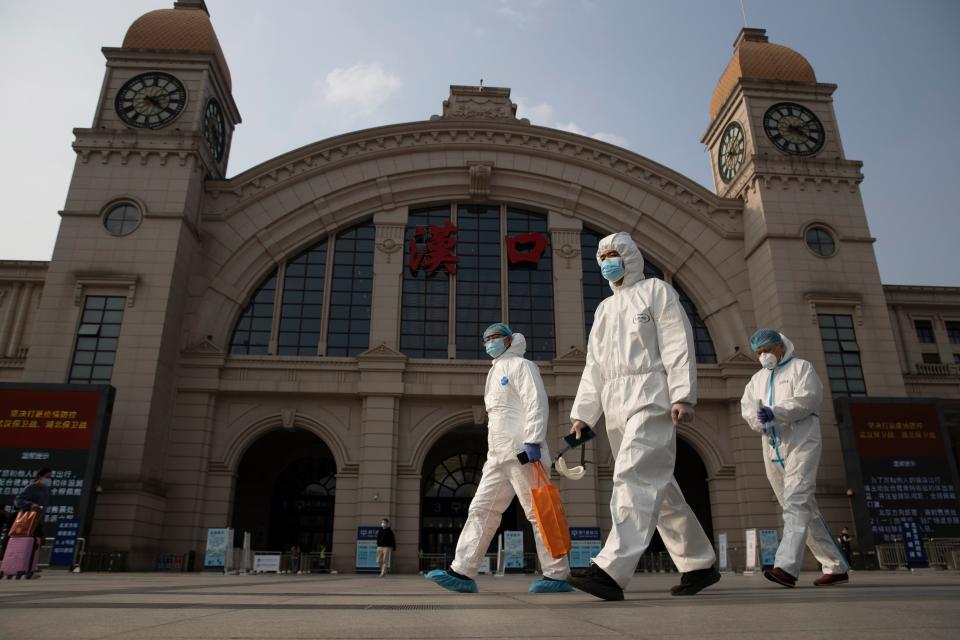US claims Wuhan lab staff had Covid symptoms earlier than first confirmed cases

Workers in protective suits walk through central Wuhan
(AP)Staff at Wuhan’s virus research institute were experiencing symptoms of Covid-19 some weeks before cases were reported by China, the United States has claimed.
In an update on Friday, the US State Department said there was reason to believe that several researchers inside the Wuhan Institute of Virology (WIV) became sick in autumn 2019, several weeks before China confirmed it was treating cases of a novel coronavirus that would later become known as Covid-19.
The claims underpin assumptions about activity at the research institute in Wuhan, which some have suspected was the source of the Covid-19 virus, and which China has denied.
While many scientists have suggested that the virus passed to humans via an infected animal, the WIV was also known to have studied coronaviruses prior to the outbreak.
According to the US State Department, Chinese researchers carried out studies on “animal-derived coronaviruses under conditions that increased the risk for accidental and potentially unwitting exposure.”
That research included RaTG13 - a bat coronavirus identified as the closest sample to SARS-CoV-2, the virus that causes Covid-19.
According to the US State Department, several researchers at WIV became ill in autumn 2019. Although no other details were provided.
A novel coronavirus outbreak was reported several weeks later, on 31 December 2019, some three weeks before officials from the World Health Organisation (WHO) confirmed human-to-human transmission of the virus, on 22 January 2020.
The US State Department did not rule-out an accident at Wuhan’s virus research institute, and instead said that the original outbreak in Wuhan was caused by “contact with infected animals or was the result of an accident at a laboratory.”
“Alternatively, a laboratory accident could resemble a natural outbreak if the initial exposure included only a few individuals and was compounded by asymptomatic infection,” the statement added.
The State Department went on to condemn the Chinese Communist Party (CCP), whose “deadly obsession with secrecy and control comes at the expense of public health in China and around the world.”
The country had spent months negotiating with WHO, who sent several investigators to begin researching the origins of the Covid-19 pandemic last week, after a months-long wait.
The US called on China to provide the WHO team with “access to the records of the WIV’s work on bat and other coronaviruses before the COVID-19 outbreak”, amid widespread condemnation of the government’s attempts to cover-up.
That has included the detention of Zhang Zhan, a citizen journalist who reported on the outbreak in Wuhan, and was imprisoned in December 2020.
The claims come seven months after American researchers pointed to satellite data that showed Wuhan’s hospitals becoming busier some months before China announced a new novel coronavirus.
Researchers at Harvard University said increases in visits to hospitals coincided with a rise in search terms for symptoms such as "cough" and "diarrhoea", and began in August 2019.
Dr John Brownstein, who led the research, told ABC news: "Clearly, there was some level of social disruption taking place well before what was previously identified as the start of the novel coronavirus pandemic”.
“This is all about a growing body of information pointing to something taking place in Wuhan at the time,” he added.
The Harvard report came almost two months after the outgoing US president, Donald Trump, said in May 2020 that he had seen evidence the Covid-19 virus might have come from the WIV.
He did not reveal more details at the time, but had been rumoured to release more information before the Friday State Department statement. He departs office on Wednesday.
Around two million people have reportedly died since the pandemic started, while some 95 million people have contracted the virus after spreading beyond China.
Read More
WHO Covid team arrives in Wuhan for investigation
World risks ‘moral catastrophe’ if Covid vaccine delayed in Africa
China introduces new Covid restrictions around Beijing
Wuhan rings in 2021 with huge crowds as Covid battle continues
Biden inauguration to include memorial service for Covid victims
WHO chief lambasts vaccine profits, demands elderly go first

 Yahoo Finance
Yahoo Finance